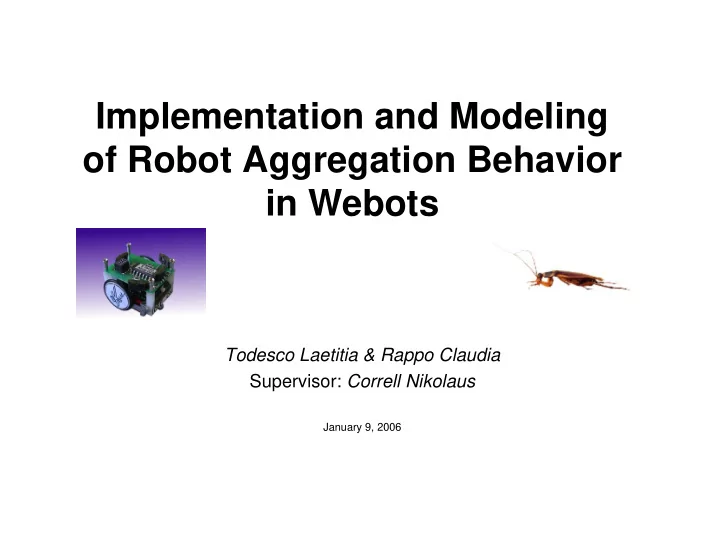

Implementation and Modeling of Robot Aggregation Behavior in Webots Todesco Laetitia & Rappo Claudia Supervisor: Correll Nikolaus January 9, 2006
Outline • Introduction to aggregation • Modeling robot aggregation in Webots • Results of the different simulations – Variations of stopping probability – Variations of sensor range • Conclusion
Aggregation • Widely observable phenomena • Two types of aggregation: – Due to environmental impact – Social interactions between members of the group • Our study concentraded on modeling and implementing aggregation behavior in Webots.
Modeling aggregation This will be the referential setting throughout our experiments, which is based on the paper on “self-organized aggregation in cockroaches” (Deneubourg, 2004)
Studying the impact of different parameters (1/2) 1. Probability of stopping 3 different configurations: • Low probability • Reference • High probability
Results (1/2) legend: In red : simulation with “low probability”, in green : simulation with “high probability” and in blue : simulation reference . Poor performance of the two different settings compared to reference
Studying the impact of different parameters (2/2) 2. Variations of sensor range 5 different configurations: • 2.0 cm • 3.5 cm • 5.0 cm • 7.0 cm (Reference) • 10.0 cm sensor range
Results (2/2) Some indications: red : 2.0, light blue : 3.5, purple : 5.0, dark blue : ref, and green :10.0 Better performance (especially sensor range 5.0 cm) of the different settings compared to reference.
Conclusion • Changing the different parameters didn’t improve performance • ‘Nature’ (reference) solves the aggregation problem in the best way • More extensive testing should be undertaken References [1] Jeanson R., Rivault C., Deneubourg J-L., Blanco S., Fournier R., Jost C.,Theraulaz G., « Self-organized aggregation in cockroaches », Elsevier Ltd., November 2004
Recommend
More recommend